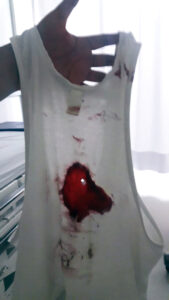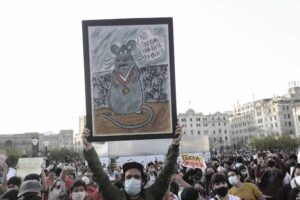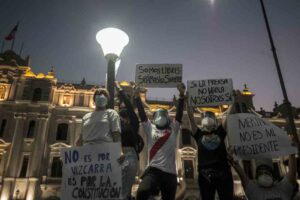Monday, Nov. 16. Peru woke up in national mourning. Mixed feelings of despair, grief and discouragement invaded the vast majority of the country of just over 33 million inhabitants. Two students were shot and killed during demonstrations and protests that had started a week earlier and were immediately met with intense repression from the National Police. Thousands took to the streets after the country’s President Martín Vizcarra was removed from office by Congress and a new leader, Manuel Merino, was sworn in. The deaths of the young men would eventually lead to the congressman’s resignation.

Protests in Lima, Peru (Flor Ruiz)
In almost a week of peaceful demonstrations throughout the country, journalists also became targets. The same day demonstrations began, the National Association of Journalists of Peru (ANP) installed an Observatory and enabled emergency lines on WhatsApp. By the time of publication of this article, it recorded 38 attacks on journalists. In 31 of them, the National Police were identified as the main aggressors.
Like the protestors, they were victims of tear gas and projectiles.
TESTIMONIES FROM THE FRONT LINES
On Nov. 12, medical personnel extracted a marble projectile, similar to those used by children for play, from photojournalist Alonso Chero Uceda, near his lumbar area.
“I was covering incidents of the march, I was recording demonstrations, clashes. There was a moment when I passed between Inambari and Leticia streets... as I passed, I felt an impact,” Chero, who works for El Comercio, told LatAm Journalism Review (LJR).
When he finally made it to a clinic, a projectile was removed.
“The only ones who were behind me at the time were the police officers, only they could have been. I have three stitches on my back, they have given me seven-day medical rest, and I have treatment to control any type of infection,” he said.

Alonso Chero's shirt (Courtesy)
The residue of the embedded pellet was detected in the left lateral area, a few centimeters from his column. The photojournalist said that, according to doctors, if that object burst in his body, it would have caused greater and irreversible damage. After this event, in statements to a newscast, Chero denounced being the victim of intimidation after reporting about the pellet and showing pictures of the wound. Up to five times, police personnel, some identified and some in civilian dress, have come to his home, asking about the projectile and requesting it be given to them. His case is being presented to the public prosecutor for investigation.
Photojournalist César Campos Medina, from El Comercio, also told LJR he was attacked and intimidated by police.
“I have covered the marches for five days. On Tuesday, I was in Plaza San Martín, photographing a crowd of people who were dispersed by tear gas bombs. While advancing from the side, a policeman tells me, move forward, and at the same time, he kicks my left leg. When the policeman was leaving, he insults me, I tell him, I'll stay here, I'm from the press. He never asked me for my credential, it wasn't hanging, it was broken, I had it with me,” Campos said to LJR.
The policeman took him by force to his superior who said he would help him.
“I am very careful when there are times of conflict, in protests. The first days of the demonstrations, media photographers, we have been more prone to being attacked. I started in the press eight years ago, it is the first time that I have felt attacked in this way. Photographers are always affected by this work, by pressure from the police, they see us as their enemies,” he said.
Photojournalist Renzo Salazar suffered a similar aggression.
“On Monday, while the protesters were going from the Plaza San Martín to the Congress, I go up to a berm, a policeman comes and tells me ‘get off,’ ‘but why?’ I ask him, and he pulls my backpack from my back, so I lose my balance,” Salazar told LJR. “I turn around, I take my hand out, I say ‘I'm from the press,’ I repeat it, then he knocked me down, I fall to the floor, there the policemen who were around, they pull me, from each arm and each leg, they take me down like that.”
According to the journalist, the police pulled off his mask and he proceeded to take pictures with his left hand.
“They knocked me down, five of them pulled me, and a photographer interceded, I force my foot, when they pulled me, so they would leave me; I could keep walking, I make sure I have my photographic equipment, and they see that I took photos of them,” he said.
“They act without criteria, by inertia. They have bad control of the situation, they repress everyone and they do not differentiate that we work, they attack us, there is no march in which we don’t tell them we are working,” he said. “I have seen how they have shot at identified people, the attacks by the police are more serious than before, this is not new. I have lost faith in the police.”
In statements by telephone, video reporter Orian Sanchez, of television channel TvMar, in the city of Puerto Maldonado, Madre de Dios region, said his face was braised by a tear gas projectile.
“I was in the square, linking up with the channel. It was a peaceful demonstration, where initially there were about 30 people, there were more than 50 policemen, it was disproportionate, there was no need for the extreme violence seen,” he told LJR. “They violently grabbed a citizen, threw him to the ground, dragged him into the street, beat him, handcuffed him. The police took detainees who were protesting in peace, they launched tear gas bombs fired by three policemen at the beginning. There was a shot, I felt there my face with blood, for three seconds I was losing consciousness, then I regained my stability.”
Though he said he was on a sidewalk away from police and protesters, he felt a gunshot on his face.
“I ran, I asked a motorcycle policeman for help, he said no. Now I wonder, if this happened to me because I received the rebound of tear gas in the face, as three witnesses told me, what would have happened if I received the direct impact: if they kill me, or I fracture my jaw,” he wondered. “For me, it was a directed, calculated, intentional impact. I was not alone, there were about ten of us. An hour and a half after the impact, the colonel arrived, he said ‘oh, what did they did to you,’ he tells a major to take me to heal. They did not cover any expenses. Since that day, I have had headaches. That same night, I threw up three times. I still have headaches, I take antibiotics for the pain,” he narrated, shocked and helpless.
Sanchez, a Venezuelan, comes from covering demonstrations in his country, where the police act disproportionately toward demonstrations, and the press is singled out as agitators. For this reason, he indignantly emphasized that this week he has seen the excessive violence of the police, that there was excess force and there was no need for the level of repression with the population in the city of the Peruvian jungle. The case of Sánchez and another journalist in Puerto Maldonado has also been denounced by the ANP.
Parallel to the attacks suffered by professional journalists, a large number of students of visual communication, journalism or related majors, have been active in covering the protests. They publish photographs and videos of the protests as part of independent media, social networks or groups that seek to make visible and transparent the intervention of young people on human rights issues.
Luis Javier Maguiña, 22, a student of communication sciences at the Pontificia Universidad Católica del Perú (PUCP, for its acronym in Spanish), was among them.
“On Thursday I went to take photos, a large ball fell on my leg, it was not a small pellet, it did not enter my thigh, thankfully, but so far, my leg is purple,” he told LJR. “I am an activist, I seek to take photographs, to raise awareness of what is happening. I want to seek transparency, to investigate, for my images to contribute to denouncing the attacks on human rights. I know that there are hard photos to record, I don’t think about winning prizes, I see those are the photos that win, the ones that show people burned, I don't want that. I have gone out every day to take pictures during this week of repression.”
Press advocates denounce attacks
At the international and national levels, various institutions condemned the repression during the tumultuous week.
The Office of the Special Rapporteur for Freedom of Expression of the Inter-American Commission on Human Rights (IACHR), expressed its “extreme concern about the excessive use of police force against protesters and journalists and toward detentions in the framework of the protests in Peru.” It reminded the government of its obligation to protect journalists so they can work freely and inform citizens.

Protests against Manuel Merino in Lima, Peru (Flor Ruiz)
The United Nations (UN) System in Peru, expressed its concern about the actions of the security forces in peaceful demonstrations, where protesters and journalists had been injured, as well as the record of violations of the rights of detained young protesters. It recalled that the Peruvian state has ratified various human rights instruments such as the International Covenant on Civil and Political Rights. It urged that “an independent, impartial and timely investigation be carried out into the events that occurred and, if applicable, reparation be made to the victims and those responsible be punished.”
On Nov. 12, the Foreign Press Association in Peru (APEP), condemned the attacks on journalists who were injured, among them, photographer Ernesto Benavides of the international news agency Agence France Press (AFP), who was hit by projectiles. APEP demanded investigations and urged respect for journalistic work.
On Nov. 16, at a Zoom press conference, the Press and Society Institute (IPYS), ANP, digital outlet Ojo Público, and the Association of Photojournalists of Peru (AFPP) exchanged accounts of press professionals injured during the protests.
IPYS highlighted the work of the country’s press and the importance of press freedom, since during demonstrations of the past week it had published information truthfully and transparently, and that the facts had been disseminated on social networks and in the media. IPYS said that despite the fact that the media have shown how police have attacked journalists, it is evident that there is a dark sector that wants the press not to inform.
Ojo Público highlighted the case of the photojournalist Alonso Balbuena, who was the victim of a brutal attack in which a police officer, a few meters away, fired a tear gas bomb, causing a serious injury to his right leg: exposure of muscle tissue, exposure of bone tissue, loss of soft tissue, loss of necrotic tissue. It stressed that it is not about demonizing the police, but about revealing their actions.
The National Police said, via a Nov. 14 press release, that it “guarantees citizens’ right to protest and calls on demonstrations to be peaceful and orderly.” It said police officers will only “make rational use of force in strictly necessary cases.”
Attacks on the press should not go unpunished
Early on Nov. 16, when the population still had not recovered from the murder of Inti Sotelo and Bryan Pintado, the young people of the "bicentennial generation," which caused the continuation of protests and resignation of the leader who was de facto president for nearly a week, the Attorney General of the Nation, Zoraida Ávalos, reported that she opened a preliminary investigation against the former president, Manuel Merino de Lama, the former prime minister, Ántero Flórez Aráoz, and the head of the Interior, Gastón Rodríguez Limo, for the alleged crimes of abuse of authority and intentional homicide of the two young people.

Protests against the swearing in of Manuel Merino (Flor Ruiz)
Various media outlets highlighted the civil, criminal and administrative responsibility of the former president, former ministers and the National Police.
In the afternoon, the new president of Congress and of the transitional government until general elections in April 2021, Francisco Sagasti, in his speech to assume office, specified that no one is going to give the two young men back their lives and he expressed solidarity with the peaceful mass demonstrations and protests of the young people. On at least two occasions, he apologized personally for the unfortunate events. He also expressed solidarity with the journalists, for whom he is going to ask for investigations into the attacks, as the work of the press revealed the repression of which they themselves were the target.